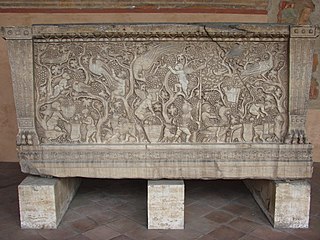Related Research Articles
The 1000s was a decade of the Julian Calendar which began on January 1, 1000, and ended on December 31, 1009.
The 1040s was a decade of the Julian Calendar which began on January 1, 1040, and ended on December 31, 1049.
The 1070s was a decade of the Julian Calendar which began on January 1, 1070, and ended on December 31, 1079.
The 1060s was a decade of the Julian Calendar which began on January 1, 1060, and ended on December 31, 1069.
The 1100s was a decade of the Julian Calendar which began on January 1, 1100, and ended on December 31, 1109.
The 950s decade ran from January 1, 950, to December 31, 959.
The 960s decade ran from January 1, 960, to December 31, 969.
The 970s decade ran from January 1, 970, to December 31, 979.
The 990s decade ran from January 1, 990, to December 31, 999.

Year 1057 (MLVII) was a common year starting on Wednesday of the Julian calendar.
The 1120s was a decade of the Julian Calendar which began on January 1, 1120, and ended on December 31, 1129.
The 1130s was a decade of the Julian Calendar which began on January 1, 1130, and ended on December 31, 1139.
The 1110s was a decade of the Julian Calendar which began on January 1, 1110, and ended on December 31, 1119.
The 1080s was a decade of the Julian Calendar which began on January 1, 1080, and ended on December 31, 1089.
The 1010s was a decade of the Julian Calendar which began on January 1, 1010, and ended on December 31, 1019.
The 1030s was a decade of the Julian Calendar which began on January 1, 1030, and ended on December 31, 1039.

Year 1032 (MXXXII) was a leap year starting on Saturday of the Julian calendar.

Year 1048 (MXLVIII) was a leap year starting on Friday of the Julian calendar.

Year 1056 (MLVI) was a leap year starting on Monday of the Julian calendar.
The 1020s was a decade of the Julian Calendar which began on January 1, 1020, and ended on December 31, 1029.
References
- ↑ Derry, T. K. (2000) [1979]. History of Scandinavia: Norway, Sweden, Denmark, Finland, and Iceland. Minneapolis, MN and London: University of Minnesota Press. p. 22. ISBN 9780816637997.
- ↑ Hubbard, Ben (2016). Viking Warriors. New York: Cavendish Square Publishing, LLC. p. 80. ISBN 9781502624550.
- ↑ Publishing, Britannica Educational (2014). Denmark, Finland, and Sweden. The Britannica Guide to Countries of the European Union. New York: Britanncia Educational Publishing. p. 177. ISBN 9781615309955.
- ↑ "Sweden Time Line Chronological Timetable of Events - Worldatlas.com". www.worldatlas.com. Retrieved 2019-08-23.
- ↑ Gregorovius, Ferdinand (2010). History of the City of Rome in the Middle Ages. Cambridge and New York: Cambridge University Press. p. 78. ISBN 9781108015035.
- ↑ Klieforth, Alexander Leslie; Munro, Robert John (2004). The Scottish Invention of America, Democracy and Human Rights: A History of Liberty and Freedom from the Ancient Celts to the New Millennium. Dallas, Lanham, Boulder, New York and Oxford: University Press of America. p. 114. ISBN 9780761827917.
- ↑ Huscroft, Richard (2013) [2009]. The Norman Conquest: A New Introduction. London and New York: Routledge. p. 64. ISBN 9781317866275.
- ↑ Rough Guides (2008). The Rough Guide to West Africa (Fifth ed.). London, New York and New Delhi: Rough Guides UK. ISBN 9781405380683.
- ↑ Moniot, Henri (December 1970). "Fouilles à Tegdaoust". Annales. Histoire, Sciences Sociales. 25 (6): 1740–1741. doi:10.1017/S0395264900159311. ISSN 0395-2649. S2CID 191878417.
- ↑ Mauny, R. A. (1954). "The Question of Ghana". Africa: Journal of the International African Institute. 24 (3): 200–213. doi:10.2307/1156424. ISSN 0001-9720. JSTOR 1156424. S2CID 143619637.
- ↑ Fryde, E. B.; Greenway, D. E.; Porter, S.; Roy, I. (1996). Handbook of British Chronology (Third revised ed.). Cambridge University Press. ISBN 0-521-56350-X.
- ↑ Insley, Charles (2011). "Remembering Communities Past: Exeter Cathedral in the Eleventh Century". In Dalton, Paul; Insley, Charles; Wilkinson, Louise J. (eds.). Cathedrals, Communities and Conflict in the Anglo-Norman World. Woodbridge, England: Boydell Press. p. 48. ISBN 9781843836209.
- ↑ Iversen, Gunilla (2000). "Transforming a Viking into a Saint: The Divine Office of St. Olav". In Fassler, Margot E.; Baltzer, Rebecca A. (eds.). The Divine Office in the Latin Middle Ages: Methodology and Source Studies, Regional Developments, Hagiography. Oxford and New York: Oxford University Press. p. 406. ISBN 9780195352382.
- ↑ Clayton, Mary (2003). The Cult of the Virgin Mary in Anglo-Saxon England. Cambridge, New York, Port Chester, Melbourne and Sydney: Cambridge University Press. p. 45. ISBN 9780521531153.
- ↑ Evans, Jeff (2011). Oliver, Garrett (ed.). The Oxford Companion to Beer. Oxford and New York: Oxford University Press. p. 831. ISBN 9780199912100.
- ↑ Wells, Mike (2016-12-14). "Dark beer and dumplings in Bavaria: a visit to the world's oldest monastic brewery". The Guardian. ISSN 0261-3077 . Retrieved 2019-08-23.
- ↑ Eames, Andrew (16 September 2016). "Move Over Oktoberfest: an Alternative Beer Pilgrimage in Bavaria" . The Independent. Archived from the original on May 1, 2022. Retrieved 23 August 2019.
- ↑ Jim Bradbury, The Capetians: The History of a Dynasty, pp. 106–108.
- ↑ Gilbert Meynier (2010) L'Algérie cœur du Maghreb classique. De l'ouverture islamo-arabe au repli (658-1518). Paris: La Découverte; p. 53.
- ↑ Fine, John V. A. Jr. (1991) [1983]. The Early Medieval Balkans: A Critical Survey from the Sixth to the Late Twelfth Century. Ann Arbor, Michigan: University of Michigan Press. p. 210. ISBN 0-472-08149-7.
- ↑ Brian Todd Carey (2012). Road to Manzikert: Byzantine and Islamic Warfare (527–1071), p. 125. ISBN 978-1-84884-215-1.
- ↑ Levtzion, Nehemia; Hopkins, John F.P., eds. (2000), Corpus of Early Arabic Sources for West Africa, New York: Marcus Weiner Press. ISBN 1-55876-241-8. First published in 1981.
- ↑ "Journal of Astronomy", part 9, chapter 56 of History of Song , first printing 1340; facsimile on frontispiece of Misner, Thorne, Wheeler Gravitation, 1973.
- ↑ "Crab Nebula". NASA.
- ↑ Brett Edward Whalen (2009). Dominion of God: Christendom and Apocalypse in the Middle Ages, p. 24 (Harvard University Press).
- ↑ Picard, Christophe (2000). Le Portugal musulman (VIIIe-XIIIe siècle. L'Occident d'al-Andalus sous domination islamique. Paris: Maisonneuve & Larose. p. 109. ISBN 2-7068-1398-9.
- ↑ MacLean, Mark (1999). "History of Ireleth and Askam-in-Furness". Bruderlin MacLean Publishing Services. Archived from the original on March 5, 2017. Retrieved March 30, 2016.
- ↑ John Julius Norwich (1991). Byzantium: The Apogee – Michael the Aged, p. 327. ISBN 0-394-53779-3.
- ↑ Jonathan Riley-Smith (2004). The New Cambridge Medieval History: Volume IV – Part II (c. 1024–c. 1198), p. 50. ISBN 978-0-521-41411-1.
- ↑ Fryde, E.B.; Greenway, D.E.; Porter, S.; Roy, I. (1996). Handbook of British Chronology, p. 217. Cambridge University Press. ISBN 0-521-56350-X.
- ↑ John Julius Norwich (1991). Byzantium: The Apogee – Isaac Komnenos on the March, p. 329. ISBN 0-394-53779-3.
- ↑ Douglas, David C. (1964). William the Conqueror: The Norman Impact Upon England, pp. 72–73. Berkeley, CA: University of California Press.
- ↑ Picard, Christophe (2000). Le Portugal musulman (VIIIe-XIIIe siècle). L'Occident d'al-Andalus sous domination islamique. Paris: Maisonneuve & Larose. p. 109. ISBN 2-7068-1398-9.
- ↑ Panton, James (2011). Historical Dictionary of the British Monarchy. Scarecrow Press. p. 16. ISBN 9780810874978.
- ↑ "Bolesław II - king of Poland". Encyclopedia Britannica. Retrieved 7 April 2018.
- ↑ John Julius Norwich (1991). Byzantium: The Apogee – The choice of a Successor, p. 336. ISBN 0-394-53779-3.
- ↑ Fine, John V. A. Jr. (1991) [1983]. The Early Medieval Balkans: A Critical Survey from the Sixth to the Late Twelfth Century. Ann Arbor, Michigan: University of Michigan Press. p. 279. ISBN 0-472-08149-7.
- ↑ The Normans in Europe, Ed. & Trans. Elisabeth van Houts (Manchester & New York: Manchester University Press, 2000), pp. 236–37.
- ↑ Brian Todd Carey (2012). Road to Manzikert: Byzantine and Islamic Warfare (527–1071), p. 127. ISBN 978-1-84884-215-1.